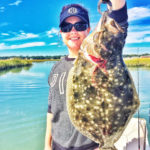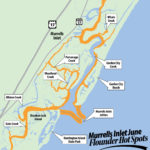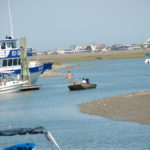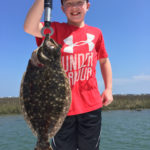
Find current and ambush points and you’ll find Murrells Inlet’s famous flounder.
As June arrives, the amount of daylight available for South Carolina fishermen.
As the first day of June arrives, the amount of daylight available for South Carolina anglers to chase fish keeps increasing until summer begins on June 21. It’s a time when flounder fishing reaches its pinnacle along South Carolina’s coast, and the waters flowing through Murrells Inlet offer a premium opportunity to land a stringer full of flatties.
The sun is higher in the sky, its rays striking the surface at a more direct angle than any other time of year. Water temperatures respond by rising a few degrees each week in June, and the warmer water brings in a buffet of groceries for flounder.
Capt. Jason Burton of Fly Girl Fishing Charters starts chasing flounder around Murrells Inlet as early as April, but June is when his engines really begin to rev up.
“June is a great time of year to catch flounder in Murrells Inlet with the abundance of bait coming in,” said Burton. “The inlet will be full of glass minnows and peanut pogies (small menhaden), and even the mullet minnows will start showing up strong, giving the flounder plenty to eat.”
Water temperatures generally in the mid- to upper 70s make for perfect conditions for flounder. And both male and female flounder flood inshore waters to fill up on as much bait as possible. And it is a good time to catch some true doormats.
“The big females migrate back into the creeks some this time of year to take advantage of the abundance of bait,” Burton said.
Knowing where and when to catch these fish is a relatively simple formula, but fishermen must first know where to find them.
“Flounder will be anywhere they can lie and ambush bait,” said Burton, describing flounder as the perfect ambush predator, lying flat on the bottom and practically undetectable as they wait for their next meal to sweep past. Minnows and shrimp scampering along the bottom have no chance when they enter the strike zone of a waiting doormat.
This month, flounder start to settle near cooler water on the edges of holes, so if the water temperatures spikes, they can drop into deeper places for relief. Burton chooses places around the estuary with a substantial, 3- to 4-foot drop in areas with current but near some type of impeding flow.
“Once the water warms up in June, they look for swift water and deep pockets. Anywhere you find a fast-moving current abutting a slower moving current or rip with a deep hole will have flounder stacked in there in the late spring and early summer,” Burton said.
Flounder may not always be set up inside the deepest part of the hole, either. Burton will fish the shallow side, the deep side and everywhere in between.
“I park in shallow water around the edge and cast into the hole, bringing the bait out slowly. They will sit around the edge or right in the middle of it,” he said.
Capt. Matt Bellamy of Dirty Boat Charters said finding a hard edge is the cat’s meow for hooking up with flounder.
“Fish cruise along the bottom and stop when they hit something where they can lay low and strike baits coming across their nose,” said Bellamy. “Oyster bars, grass edges, jetty rocks, creek mouths and points create ample ambush positions.”
Baitfish and shrimp use the marsh grass and shallow water as refuges from most predators. As a result, some of the best flounder fishing comes when the water is dropping out of the grass, pulling bait into main tributaries. Bellamy likes the last two hours of the falling tide and the first two hours of the rising tide when current moves bait past ambush spots.
“The bait will have nowhere to go when the water falls out of the grass. I believe the flounder can actually feel the vibrations in the water from all of the baitfish and shrimp flickering around,” Bellamy said.
Since baitfish will be thick from the headwaters of Garden City Creek all the way to Huntington Island at the back of Oaks Creek, excellent flounder waters are practically everywhere. However, flounder won’t be stacked at every ambush point from north to south, either. While there are always certain places that flounder routinely call home on particular tides, a good fisherman will stay on the move most of the day, checking ambush spots without pausing too long in any one place.
According to Burton, flounder will bite fairly quickly if they are there and if the bait is presented in the right spot. But if 20 minutes of hard fishing yield empty results, that’s a sure sign to move on to the next spot. However, if a fish is caught, anglers should slow down and fish the area thoroughly, because flounder are far from solitary.
“If you ever catch a flounder along a rip or on the edge of a hole, you better fish it hard for at least 30 more minutes, because they stack up on top of each other. There are three or four more in the same spot,” said Burton.
Rigging is not very complicated. Fishermen using live bait should employ a two-hook rig with a 1- to 1 1/2-ounce sinker or a bright, ¼-ounce jighead. They can be fan-cast and slowly fished back to the boat or trolled slowly. Bellamy is a fan of slow-trolling against the current to cover as much ground as possible.
“I always troll when I can, and going as slowly as possible against the current. Got to go slow to give the fish plenty of time to take the bait,” he said.
As the summer heat pushes the water temperatures into the 80s by the end of the month, many flounder retreat to deeper water with more stable water temperatures around the jetties and around nearshore reefs. But until then, Murrells Inlet anglers can have their time reeling in a limit of flatties for the frying pan.
DESTINATION INFORMATION
HOW TO GET THERE — Murrells Inlet is at the southern tip of the Grand Strand and is easily accessible from the public boat ramp on U.S. 17 Business, just south of the heart of Murrells Inlet’s famous restaurant district and Crazy Sister Marina.
WHEN TO GO — Flounder begin moving into the inshore waters of Murrells Inlet in the early spring as the water temperature rises through the 60-degree mark. Flounder will scatter at first but then congregate in main creeks and tributaries. They’ll stay until the fall until the water cools and moves them back tot he ocean.
TACKLE/TECHNIQUES — Baitcasting and spinning tackle both perform well on flounder; rods should be at least 7-foot, with medium-heavy actions and reels spooled with 20-pound braid and a 40-pound fluorocarbon leader. Live mud minnows, menhaden and finger mullet are top baits, but live or cut shrimp and squid strips will also produce. Use a Carolina rig with an egg sinker not to exceed 3/4-ounce with small hooks, No. 1 or smaller. Leaders should be 18 to 24 inches. Brightly colored jigheads are great for live baits and artificials, including soft-plastics in 4- to 5-inch versions. The Vudu mullet and shrimp and various Gulp baits are good choices. You can anchor up or drift. Current flow is more important than tidal stage, as flounder are ambush feeders, so avoid slack tides.
FISHING INFO/GUIDES — Capt. Jason Burton, Fly Girl Fishing Charters, 843-798-9100, www.flygirlfishingcharters.com; Capt. Matt Bellamy, Georgetown Dirty Boat Charters, 843-568-8203; Perry’s Bait & Tackle, 843-651-2895; Pawley’s Island Outdoors, 843-979-4666.
ACCOMMODATIONS — Hampton Inn, Murrells Inlet, 843-651-6687; Myrtle Beach Area Convention and Visitors Bureau, www.visitmyrtlebeach.com; the South Carolina Association of Visitors Bureaus, www.discoversouthcarolina.com.
MAPS — Navionics, 800-848-5896, www.navionics.com; Waterproof Charts (Near shore #98), www.waterproofcharts.com, 800-423-9026; SeaLake Fishing Guides, 800-411-0185, www.sealakeusa.com.








Be the first to comment